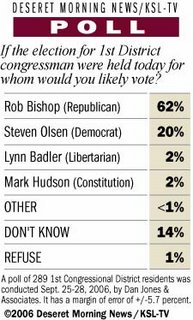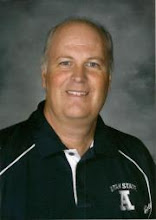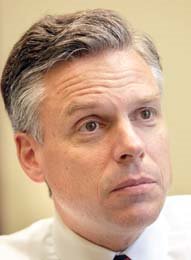Congressman Joe Cannon?


Poll shows challengers are significantly behind
Copyright 2006 Deseret Morning News
By Lisa Riley RocheDeseret Morning News
So far, voters are only moderately interested in the upcoming general election, according to a new poll — not surprising, since the incumbents at the top of the ticket all hold strong leads. Four of the five members of Utah's congressional delegation are up for re-election in November — Sen. Orrin Hatch, Rep. Rob Bishop and Rep. Joe Cannon, all Republicans, and Rep. Jim Matheson, the lone Democrat. A new Deseret Morning News/KSL-TV poll found that all but Cannon have the support of at least 60 percent of the Utahns surveyed. Cannon, the only incumbent who faced a primary election, had 53 percent. None of the opponents were favored by more than about one-fourth of the Utahns surveyed — a total sample of 922 registered voters statewide for the Senate race and 300 in each congressional district. Even in the most contested race, in the 2nd District, Matheson holds a 36 percent lead over his GOP opponent, state Rep. LaVar Christensen, R-Sandy. Sixty percent of the voters said they would pick Matheson if the election were held today and 24 percent would cast a ballot for Christensen. The poll was taken Sept. 25-28 by Dan Jones & Associates and has a margin of error of plus or minus 3 percent for the statewide race and approximately plus or minus 5.5 percent in each congressional district. Voters were also asked about their level of interest in the Nov. 7 general election. Most, 59 percent, expressed moderate interest. Those numbers did not vary much by congressional district. State Republican and Democratic party officials said the results are to be expected in what so far seems to be a pretty low-key election. "It is not an exciting political year," said Jeff Hartley, executive director of the Utah Republican Party. And unless the sales tax increase for transportation projects that's on the ballot in Salt Lake County generates a lot of interest, Hartley predicted a low voter turnout, something that typically favors sitting officeholders. "That's good news for incumbents," Hartley said. But not for Republicans who are trying to unseat Matheson in a largely GOP district. "To close the gap with Matheson, who is a strong incumbent, Christensen needs to remind people why they're Republican," Hartley said. And, he said, the GOP could lose its majority in Congress this election. "The House of Representatives literally hangs in the balance this time," Hartley said. "Although Matheson may be a likeable guy here in Utah, giving control of the House to Washington Democrats is not something Utah voters want to see." Todd Taylor, executive director of the Utah Democratic Party, said that could sway some GOP voters who back Matheson, but not enough to cost him the election. "It is probably their most effective argument for calling people home," Taylor said. Jones said Matheson needs 20 percent of the Republi- cans to vote for him in order to retain his seat. According to the poll, 35 percent of those surveyed who said they were Republicans backed Matheson. Just over half — 53 percent — of the GOP members polled said they would vote for Christensen, while 9 percent said they didn't know who they'd support. None of the respondents who identified themselves as Democrats said they support Christensen. Both Taylor and Hartley said they expect all the races to get closer as the election nears and voters start paying more attention. "I definitely expect things to tighten up a little bit," Taylor said. "People want to do their civic duty."
Copyright 2006 Deseret Morning News
By Lisa Riley RocheDeseret Morning News
So far, voters are only moderately interested in the upcoming general election, according to a new poll — not surprising, since the incumbents at the top of the ticket all hold strong leads. Four of the five members of Utah's congressional delegation are up for re-election in November — Sen. Orrin Hatch, Rep. Rob Bishop and Rep. Joe Cannon, all Republicans, and Rep. Jim Matheson, the lone Democrat. A new Deseret Morning News/KSL-TV poll found that all but Cannon have the support of at least 60 percent of the Utahns surveyed. Cannon, the only incumbent who faced a primary election, had 53 percent. None of the opponents were favored by more than about one-fourth of the Utahns surveyed — a total sample of 922 registered voters statewide for the Senate race and 300 in each congressional district. Even in the most contested race, in the 2nd District, Matheson holds a 36 percent lead over his GOP opponent, state Rep. LaVar Christensen, R-Sandy. Sixty percent of the voters said they would pick Matheson if the election were held today and 24 percent would cast a ballot for Christensen. The poll was taken Sept. 25-28 by Dan Jones & Associates and has a margin of error of plus or minus 3 percent for the statewide race and approximately plus or minus 5.5 percent in each congressional district. Voters were also asked about their level of interest in the Nov. 7 general election. Most, 59 percent, expressed moderate interest. Those numbers did not vary much by congressional district. State Republican and Democratic party officials said the results are to be expected in what so far seems to be a pretty low-key election. "It is not an exciting political year," said Jeff Hartley, executive director of the Utah Republican Party. And unless the sales tax increase for transportation projects that's on the ballot in Salt Lake County generates a lot of interest, Hartley predicted a low voter turnout, something that typically favors sitting officeholders. "That's good news for incumbents," Hartley said. But not for Republicans who are trying to unseat Matheson in a largely GOP district. "To close the gap with Matheson, who is a strong incumbent, Christensen needs to remind people why they're Republican," Hartley said. And, he said, the GOP could lose its majority in Congress this election. "The House of Representatives literally hangs in the balance this time," Hartley said. "Although Matheson may be a likeable guy here in Utah, giving control of the House to Washington Democrats is not something Utah voters want to see." Todd Taylor, executive director of the Utah Democratic Party, said that could sway some GOP voters who back Matheson, but not enough to cost him the election. "It is probably their most effective argument for calling people home," Taylor said. Jones said Matheson needs 20 percent of the Republi- cans to vote for him in order to retain his seat. According to the poll, 35 percent of those surveyed who said they were Republicans backed Matheson. Just over half — 53 percent — of the GOP members polled said they would vote for Christensen, while 9 percent said they didn't know who they'd support. None of the respondents who identified themselves as Democrats said they support Christensen. Both Taylor and Hartley said they expect all the races to get closer as the election nears and voters start paying more attention. "I definitely expect things to tighten up a little bit," Taylor said. "People want to do their civic duty."







